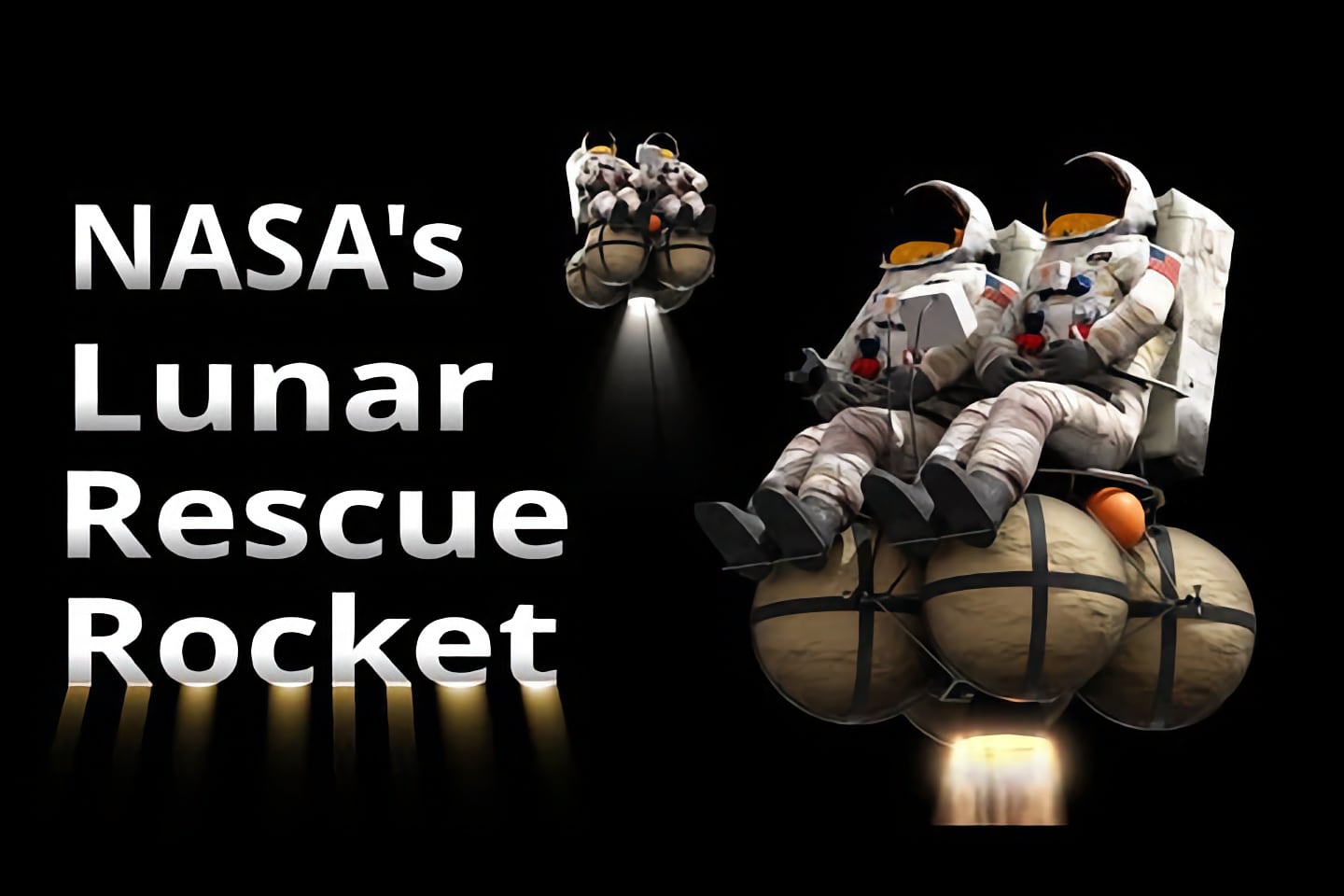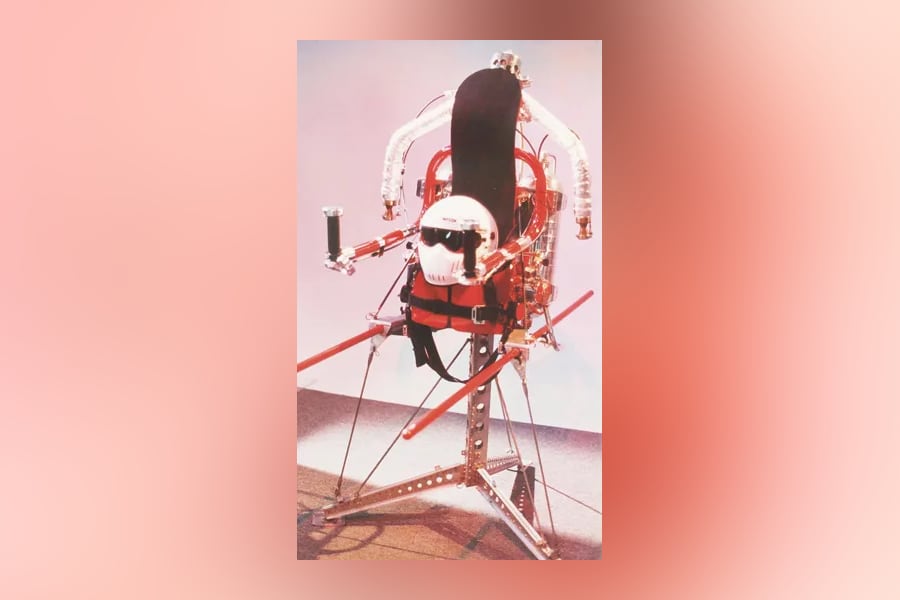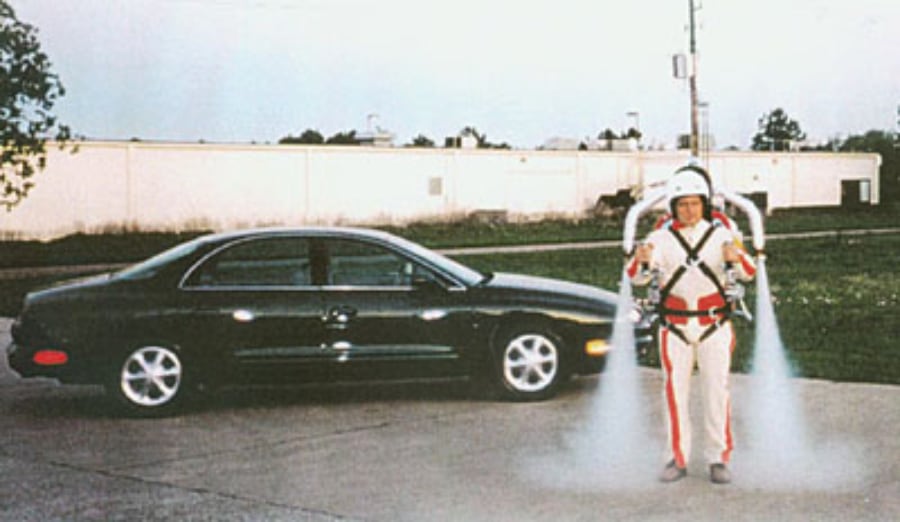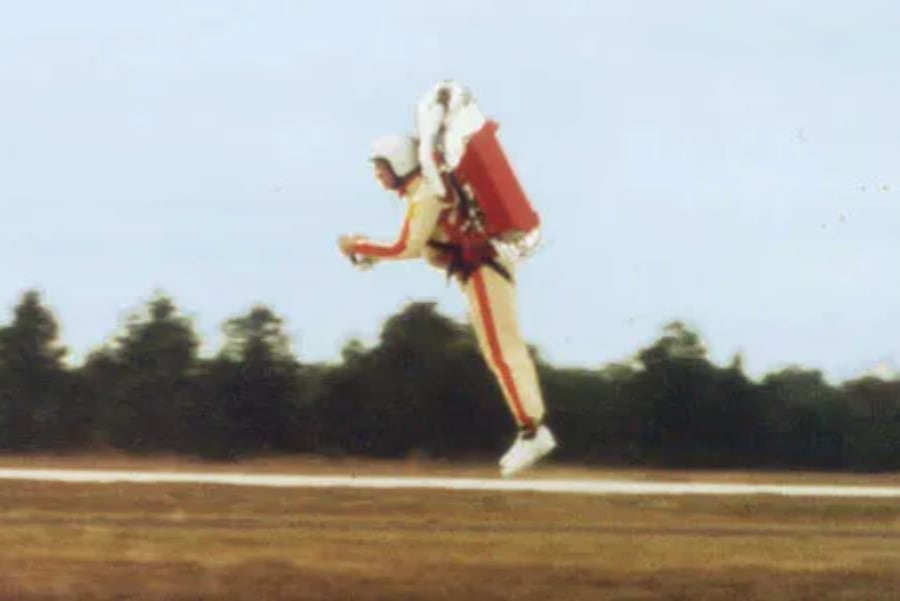In 1995, test pilot Bill Suitoril was ready for one of the most important flights of his life.
He put on a 60kg Rocket Belt 2000 backpack, pressed a button and took off into the air. His flight lasted about 28 seconds, but that didn’t matter. The main thing is that flying on a jetpack has become a reality.
Rocket Belt 2000 was developed by the American company American Rocket Belt Corporation, which was founded in 1992 by Joe Wright, Brad Barker and Larry Stanley. In a few years, one of the founders will be killed, the second will be kidnapped, the third will be imprisoned for the imprisonment of the second. And no one will see a bigger invention.
Initially, three science fiction fans wanted to create a jetpack and get rich.

Wendell Moore puts Bell Rocket Belts on a test pilot
Jetpack Tried to be created throughout the 20th century. In 1960, engineer Wendell Moore created the Bell Rocket Belts, a jetpack that could actually fly just as described in science fiction.
He worked on the project for 7 years, and in 1959 he signed a contract with the US Army. The military eventually abandoned the use of the backpack due to the 20-second flight limit..
Since 1961, Moore had conducted many tests and needed volunteer pilots. Moore decided to offer the job to his 19-year-old neighbor, Bill Suitor.

Bell Rocket Belts
Later, in 1965, Suitor was cast as a stunt double in the James Bond film Thunderball. He performed all the special effects on Bell Rocket Belts lively.
Moore himself, after abandoning the military, proposed the idea of NASA. It contracted with NASA to develop lunar capabilities using its rocket system. The result of the work was the Lunar Escape Astronaut Pogo, which used jetpack technology to transport astronauts to the Moon.

But the project had to be abandoned because engineers could not solve problems with short flight time and rapid fuel burn.
In 1973, Moore donated one of the jetpacks to the Smithsonian Institution. The project has since been permanently closed.

Bill Suitor flew Bell Rocket Belts during the opening of the 1984 Olympic Games in Los Angeles.
But in the early 90s, Brad Barker, an insurance agent with an interest in jetpacks, wanted to create his own jetpack. He found other similar enthusiasts, and together they organized the American Rocket Belt Corporation.
Barker provided the analysis and engineering, Stanley sponsored the entire project, and Wright provided free space and equipment. According to Barker, all three wanted to create a jetpack and make a lot of money.
In two years they created the RB 2000 jetpack.

RB 2000, mounted on a special holder
All three came to the conclusion that Moore’s invention needed to be improved. Therefore, the RB 2000 is very similar to Moore’s rocket pack, but there are important differences between the two:
▪️ RB 2000 could fly for 28, not 20 seconds.
▪️ The maximum height with RB 2000 is 30 meters, not 18.
▪️ The maximum speed of the RB 2000 is 96 km/h, not 55 km/h.
▪️The weight of RB 2000 is 60 kg, not 57 kg.
In 1994, they created a prototype and invited Bill Suitor to refine the invention and conduct the first flight of the RB 2000 in Houston. Suitor was then (and still is) the most experienced jetpack test pilot.. He has several hundred flights under his belt.
The flight was successful, despite Suitor’s comments.
The RB 2000 had serious underlying flaws that made it very difficult to fly and control, and to make matters worse, it could still only fly for about 21 seconds. You can read or hear anything related to this question, but I am the only person who has ever flown all three versions. [включая Bell Rocket Belts и Tyler NT-1 — прим. iPhones.ru]and at the time of writing this article I am the only person who has flown the RB 2000, so what I write is the absolute truth.
Bill Suitor
But the technical aspects of the Rocket Belt turned out to be the least of American Rocket Belt Corporation’s problems.
One of the company’s founders stole a jetpack

From left to right: Joe Wright, Larry Stanley and Brad Barker
The fate of the American Rocket Belt Corporation was doomed long before Suitor’s first flight on the RB 2000.
Barker and Stanley could not find a common language and soon began to quarrel constantly. Joe Wright had another business producing car audio systems, but it began to cause harm, and Wright himself became addicted to hard drugs.
Even before the RB 2000’s first flight, Barker and Stanley had a heated argument. Barker was believed to be stealing money from the company.
Stanley hit me in the face. I grabbed a five-pound, sunny, lead-filled hammer from the table. I gave Stanley short blows to the back of the head twice. This is where the cooperation ended.
From Barker’s memoirs
After this meeting, Barker grabbed the RB 2000 and fled.
While watching a basketball game in Houston, Stanley saw Bill Suitor’s first flight in the RB 2000 on television. Stanley contacted Wright in hopes of tracking down Barker together, but it didn’t work out.
Immediately after the flight, Barker equipped a backpack in the car and disappeared again.
Stanley decided to take Barker to court to get back her money invested in the company. But for this he needed RB 2000. The problem was that by 1999, when the maintenance of the claim began, only one person could provide the circumstances.
The second founder of the company killed

Bill Suitor tests the RB 2000
Eleven days before the trial, someone entered Joe Wright’s house, knocked on the door, and when he opened it, he was beaten to death with a blunt force lock.
The injuries were so severe that it was impossible to recognize the face. The main suspect was Brad Barker.. Police arrested and questioned him, but released him three days later because the police did not have enough evidence to re-arrest Barker. Immediately after this, Barker disappeared, taking the RB 2000 with him.
Barker did not appear for Stanley’s trial. As a result, the judge ruled in Stanley’s favor, awarding him more than US$10 million and RB 2,000.
Stanley kidnapped Barker to get the RB 2000 and money back.
Test flight of RB 2000 in 1995
Since Joe Wright was dead, he opened up his entire debt to Barker. But he agreed to pay and wouldn’t say where the RB 2000 was, so Stanley decided to grant the certificate.
Having tracked down Barker’s place of residence, Stanley wrote him a letter on behalf of one of the Hollywood companies with an offer to work. When Barker left the house, he was grabbed by four men and taken away in an unknown direction.
For eight days, Barker was kept in a small box visible in a shipping container. Stanley threatened and tortured Barker in every possible way. He drilled holes in the container with the words “the more holes, the faster it will sink.” Last few days Stanley put a gun to Barker’s head and forced him to sign documents transferring the rights to the RB 2000..
Eight days later, Barker was able to remove his handcuffs and escape. He called his brother, told the whole story and contacted the FBI. Within 24 hours, Barker had lost 10.5 kg and had eight cuts on his wrists, reaching almost to the bones.
Sad ending to the story
In 2002, Stanley and his message were sentenced to life in prison, but the sentence was later reduced to 8 years.
The murder of Joe Wright remains unsolved. His sister believes Stanley killed Wright to frame Barker.
No one has seen RB 2000 since then. In 2002, Barker was asked if anyone would see the RB 2000, to which Barker replied: “I never know.”
Source: Iphones RU
I am a professional journalist and content creator with extensive experience writing for news websites. I currently work as an author at Gadget Onus, where I specialize in covering hot news topics. My written pieces have been published on some of the biggest media outlets around the world, including The Guardian and BBC News.












